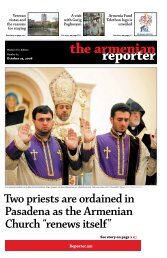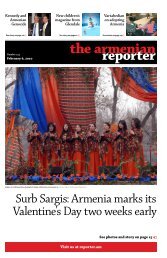The prince charming of Armenian pop - Armenian Reporter
The prince charming of Armenian pop - Armenian Reporter
The prince charming of Armenian pop - Armenian Reporter
Create successful ePaper yourself
Turn your PDF publications into a flip-book with our unique Google optimized e-Paper software.
in France, but he was constantlypulled to drawing. He won manyprizes and during financially difficulttimes, he supported himselfwith his passion by drawing caricaturesand political cartoons forlocal newspapers and magazines.He started to make his mark onthe art world in his early 20s andby the 1940s he was well known inthe field.According to K’eoseyan, Carzoudidn’t belong to any school <strong>of</strong> art,dabbling in a range <strong>of</strong> movementsfrom naturalism to cubism, surrealismto imagery and back to thenaturalist art movement.“When we study Carzou’s workin its entirety, we observe that itsevolution – with all the inherenttransmutations – forms a circularcourse, and that the artist <strong>of</strong>tenreturns to his original point <strong>of</strong> departure,enriched by maturity, experienceand crystalline pr<strong>of</strong>oundnessattained during the decades,”K’eoseyan wrote.But Carzou was most comfortablein naturalism, stemming fromhis belief that nature transcendsman, and that its ability to live onand regenerate is a testament toits pr<strong>of</strong>ound truth.Most <strong>of</strong> his work is markedby the presence <strong>of</strong> women. ForCarzou women represented peaceand the rebirth <strong>of</strong> mankind, incontrast to the wars and machinescreated by man.“She is everywhere, in every period,the commanding figure, indivisiblefrom Carzou’s universe andits distinctive characteristics. <strong>The</strong>Carzou woman . . . More accuratelya goddess,” K’eoseyan explained.Though Carzou was primarily apainter, his art is not limited toworking on canvas. He worked ontextured, unusual surfaces includingporcelain, tapestries, and ceramics.His body <strong>of</strong> work includes departuresfrom traditional paintingsto illustrating books bywriters including Albert Camus,Shakespeare, Rimbaud, and ErnestHemingway and even helpingdecorate the ocean liner “<strong>The</strong>France.”Carzou gained instant fame in1952 for his set designs and costumesfor the Comedie Francaiseand the top ballet and opera houses<strong>of</strong> Paris, including the ParisOpera, and the Harkness DanceCompany <strong>of</strong> New York.Though he did quite a few stagedesigns, Carzou admitted thatthey took too much time from hisother creative endeavors, so hedecided to return to his paintings.At the age <strong>of</strong> 81, Carzou completedpainting the walls <strong>of</strong> achapel in the south <strong>of</strong> France. Hepainted the Apocalypse <strong>of</strong> SaintJoan in the Chapel at Monosquein Vaucluse, France. This chapelbecame a tribute to the artistwhen in 1995 it was dedicated asthe Museum de Jean Carzou.He even left an indelible markin the artistic world when in thelate 1930s his work took on color.He created a distinct shade <strong>of</strong> emeraldblue and later in his careera distinct shade <strong>of</strong> deep, flamingred, known today as “Carzou Blue”and “Carzou Red” respectively.<strong>The</strong> artist named one <strong>of</strong> the 10major painters <strong>of</strong> his generationin a 1955 survey conducted by theConnaissance des Arts magazinewas primarily influenced by music– especially <strong>Armenian</strong> music– which inspired him to paint.Carzou had more than 100 soloexhibitions all around the world,including one in 1943 when hesold 30 <strong>of</strong> his 40 canvases in oneevening.His work was so prominent thatin 1976 he became the first livingartist to have one <strong>of</strong> his drawingsappear on a French postagestamp.But while his work appealed tothe public, Carzou was not embracedby art critics, according tothe August 2000 obituary in theLondon newspaper, <strong>The</strong> Independent.La Reine, 1972,oil on canvas65 x 54cm.<strong>Armenian</strong> <strong>Reporter</strong> Arts & Culture 11/10/2007C17

















